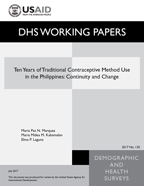- PUBLICATIONS
- JOURNAL ARTICLES
- ORDER PUBLICATIONS
Publications Summary
- Document Type
- Working Papers
- Publication Topic(s)
- Family Planning
- Country(s)
- Philippines
- Language
- English
- Recommended Citation
- Marquez, M. P. N., M. Kabamalan, and E. Laguna. 2017. Ten Years of Traditional Contraceptive Method Use in the Philippines: Continuity and Change. DHS Working Papers No. 130. Rockville, Maryland, USA: ICF.
- Download Citation
- RIS format / Text format / Endnote format
- Publication Date
- July 2017
- Publication ID
- WP130
Download
 Ten Years of Traditional Contraceptive Method Use in the Philippines: Continuity and Change (PDF, 905K)
Ten Years of Traditional Contraceptive Method Use in the Philippines: Continuity and Change (PDF, 905K)
